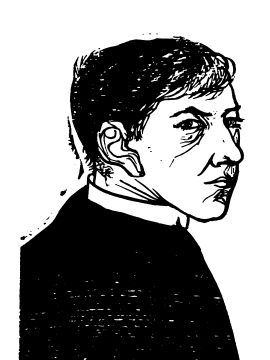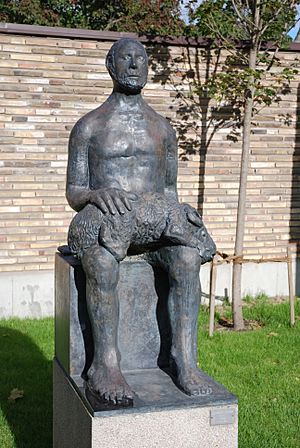Leonard Baskin facts for kids
Quick facts for kids
Leonard Baskin
|
|
|---|---|

Self-Portrait as Priest, 1952
|
|
| Born | August 15, 1922 New Brunswick, New Jersey, US
|
| Died | June 3, 2000 (aged 77) Northampton, Massachusetts, US
|
| Nationality | American |
| Education | New York University Yale University The New School (BA) Académie de la Grande Chaumière Accademia di Belle Arti |
| Known for | Sculpture, book illustration, printmaking, graphic design, founder of the Gehenna Press |
| Movement | Boston Expressionism |
| Awards | Prix de Rome, Gold Medal of The American Academy of Arts and Letters, Special Medal of Merit of the American Institute of Graphic Arts, Gold Medal of the National Academy of Design, Widener Medal from the Pennsylvania Academy of the Fine Art |
Leonard Baskin (born August 15, 1922 – died June 3, 2000) was an American artist. He was famous for his sculptures, drawings, and prints. He also started a special publishing company called Gehenna Press in 1942. This press was one of the first in America to focus on fine art books. It became very important worldwide.
The Gehenna Press often featured the work of famous poets. These included Sylvia Plath and Ted Hughes. Baskin's own art was bold and strong. He often used black-and-white prints. The New York Times called him a "Sculptor of Stark Memorials." He made art from wood, limestone, and bronze. His large woodblock prints were sometimes natural and sometimes very imaginative. They often showed figures that looked a bit strange or humans mixed with animals. One of his most famous sculptures, The Funeral Cortege, is at the Franklin Delano Roosevelt Memorial in Washington, D.C.
Contents
Important Artworks
Leonard Baskin was a figurative artist. This means he focused on showing the human form in his art. His father and brother were rabbis. Because of this, his work often explored themes like life, death, and his Jewish faith. He also created art about the Holocaust.
Baskin once said, "Our human frame... is yet a glory." He believed the human figure was powerful. It could show what all people share and what makes each person unique. He felt it could express everything. This idea was different from the abstract expressionist movement. That style was popular during his lifetime. Baskin did not agree with it.
In 1956, Baskin had his first big art show. It was at the Boris Mirski Gallery in Boston. He went on to have over 40 more shows. In 1966, a film called "Images of Leonard Baskin" was made about him. In 1972, he won an award for his illustrations in the book Hosie’s Alphabet. His wife, Lisa, and sons, Tobias and Hosea, wrote the book.
In 1994, Baskin received a major project. He created a 30-foot sculpture for the Franklin Delano Roosevelt Memorial. He also made a bronze statue for the Holocaust Memorial in Ann Arbor, Michigan.
The Gehenna Press
Baskin started the Gehenna Press in 1942. He was a student at Yale University at the time. He was inspired by the illustrated books of William Blake. He wanted to learn how to print and make his own books. The press's name came from a line in the poem Paradise Lost. It printed over 100 books. The Gehenna Press continued until Baskin passed away in 2000.
In 1974, Baskin moved to Britain with his family. He wanted to be near his friend, the poet Ted Hughes. Baskin had illustrated Hughes's poetry book Crow in 1970. Baskin and Hughes worked together on several other books. These included A Primer of Birds. Other poets also worked with the Gehenna Press. These included James Baldwin and Anthony Hecht. The poet Sylvia Plath even dedicated a poem to Leonard Baskin.
In 1992, there was a special exhibition. It showed 50 years of books from the Gehenna Press. It traveled across the country. A big show was held at the Library of Congress.
Education and Teaching
Leonard Baskin decided to become a sculptor when he was 15. He studied with Maurice Glickman from 1937 to 1939. He also studied at New York University from 1939 to 1941. In 1941, he won a scholarship to Yale. He studied there for two years and started the Gehenna Press.
Baskin served in the US Navy during World War II. After the war, he studied at The New School for Social Research. He earned his bachelor's degree in 1949. In 1950, he went to Paris to study art. The next year, he studied in Florence, Italy.
From 1952 to 1953, he taught printmaking at the Worcester Art Museum. In 1953, he began teaching at Smith College in Northampton, Massachusetts. He taught printmaking and sculpture for 20 years. After living in England for several years, Baskin returned to the U.S. in 1984. He then taught at Hampshire College.
Art in Public Collections
Baskin's art is displayed in many major museums around the world. Some of these include:
- Art Institute of Chicago
- British Museum
- Brooklyn Museum
- Detroit Institute of Arts
- Hirshhorn Museum and Sculpture Garden
- Library of Congress
- Metropolitan Museum of Art
- MOMA
- Museum of Fine Arts, Boston
- National Gallery of Art
- Smithsonian American Art Museum
- Victoria and Albert Museum
- Vatican Museums
- Whitney Museum of American Art
The Bodleian Library in Oxford, England, bought the collection of his work from the Gehenna Press in 2009. The McMaster Museum of Art in Hamilton, Ontario owns over 200 of his artworks. Most of these were given by his brother, Rabbi Bernard Baskin. The Philadelphia Museum of Art has more than 800 of his works.
Awards and Honors
Baskin received six honorary doctorates. He was also a member of important art academies in Belgium, Italy, and the U.S. In 2000, he received the Jewish Cultural Achievement Award in Visual Arts. Other awards and honors include:
- Gold Medal of The American Academy of Arts and Letters
- Gold Medal of the National Academy of Design
- Guggenheim Fellowship for Creative Printings
- Louis Comfort Tiffany Foundation Fellowship for Sculpture
- Prix de Rome, Honorable Mention for Sculpture
- Special Medal of Merit of the American Institute of Graphic Arts
- Widener Medal from the Pennsylvania Academy of the Fine Art
Personal Life
Leonard Baskin was born in New Brunswick, New Jersey. When he was seven, his family moved to Brooklyn, New York. His first cousin was the famous dancer Sophie Maslow. His first wife, Esther Baskin, was a nature writer. She wrote books like Creatures of Darkness. They had a son named Tobias. Esther passed away in 1973. Leonard Baskin died on June 3, 2000, at age 77. He passed away in Northampton, Massachusetts, where he lived. He was survived by his second wife, Lisa Unger Baskin, and their two children, Hosea and Lucretia.
See also
 In Spanish: Leonard Baskin para niños
In Spanish: Leonard Baskin para niños


